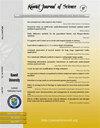用芝麻油基胶体系统制备氧氟沙星纳米胶囊:抗菌、毒性和给药研究
IF 1.1
4区 综合性期刊
Q3 MULTIDISCIPLINARY SCIENCES
引用次数: 0
摘要
药物的疏水性和消化酶降解需要一种创新的方法,其中包括采用纳米级胶体系统进行药物递送。采用机械化学法制备乳剂,并用FTIR、UV-Vis光谱、Zetasizer、1HNMR和cro - tem进行表征。研究了芝麻油基纳米乳(SOBN)、负载氧氟沙星的芝麻油基纳米乳(SOBN + of)和氧氟沙星(of)对金黄色葡萄球菌、肺炎克雷伯菌、金黄色葡萄球菌(ATCC 29213)和铜绿假单胞菌(ATCC 15442)的抑菌活性。用成年雄性Wistar大鼠进行SOBN + of的给药研究。zeta电位测量结果显示为带负电的乳液(−16.1mV),具有较低的多分散性指数值,表明其稳定性较高。低温透射电镜观察到一个平均直径为610.4±0.54 nm的粗糙球形胶体,有效电场强度为147.4 V。紫外-可见法测得的药物包封效率最高为21.250 μg/mL。FTIR显示了SOBN和SOBN + of的叠加,波数值为3427.76 cm−1,这与1HNMR结果一致,表明了封装。分子研究表明,肽聚糖去乙酰化酶(革兰氏阳性)和β -内酰胺酶A类(革兰氏阴性)细菌蛋白的最高对接值分别为- 6.67291594和- 7.09475231。抗菌研究表明,在500 ~ 31.25 mg/mL的浓度范围内,SOBN + OF比OF更有效。研究剂量(17.5 mL/kg bw) SOBN + of对Wistar大鼠的毒性有病理形态学影响。SOBN + of处理的大鼠皮肤吸收值为0.0980 μg/mL,渗透率显著。透皮-药理学实验显示,150 min时Cmax值为2.31 μg/mL。本研究结果表明,芝麻油基纳米乳是一种可能的载体,具有封装、运输和释放氧氟沙星的潜力,从而提高其生物效价。本文章由计算机程序翻译,如有差异,请以英文原文为准。
Nanoencapsulation of ofloxacin using sesame seed oil-based colloidal system: antimicrobial, toxicity, and drug delivery studies
Hydrophobicity and gastroenzymatic degradation of drugs requires an innovative approach, which includes the adoption of a nanosized colloidal system for drug delivery. The emulsions were produced by the mechano-chemical method and characterized using FTIR, UV–Vis spectroscopy, Zetasizer, 1HNMR, and Cryo-TEM. Molecular studies and antimicrobial activity of sesame oil-based nanoemulsion (SOBN), ofloxacin-loaded sesame oil-based nanoemulsion (SOBN + OF), and ofloxacin (OF) were carried out on S. aureus, K. pneumoniae, S. aureus (ATCC 29213), and P. aeruginosa (ATCC 15442). Drug delivery studies of SOBN + OF were done using adult male Wistar rats. The zeta potential measurement shows a negatively charged emulsion (−16.1mV), with low polydispersity index values, which suggests high stability. The Cryo-TEM micrographs show a rough spherical colloid with an average diameter of 610.4 ± 0.54 nm and an effective electric field strength value of 147.4 V. The UV–Vis analysis recorded a maximum drug entrapment efficiency of 21.250 μg/mL. The FTIR shows a superimposition of SOBN and SOBN + OF spectra with a wavenumber value of 3427.76 cm−1, which is in agreement with the 1HNMR results, suggesting an encapsulation. The molecular studies show that the highest docking values of −6.67291594 and −7.09475231 were recorded on peptidoglycan deacetylase (gram-positive) and beta-lactamase class A (gram-negative) bacterium protein, respectively. The antimicrobial study shows that SOBN + OF is more potent than OF across a concentration range of 500 to 31.25 mg/mL. The toxicity of the investigated dosage (17.5 mL/kg bw) of SOBN + OF has a pathomorphological effect on Wistar rats. The SOBN + OF-treated rat skin had an absorption value of 0.0980 μg/mL, indicating a significant penetration rate. A recorded Cmax value of 2.31 μg/mL was noted at 150 min in the transdermo-pharmaceutical study. The outcome of this study shows that sesame oil-based nanoemulsion is a probable vehicle, with the potential to encapsulate, transport, and release ofloxacin, thereby enhancing its biopotency.
求助全文
通过发布文献求助,成功后即可免费获取论文全文。
去求助
来源期刊

Kuwait Journal of Science
MULTIDISCIPLINARY SCIENCES-
CiteScore
1.60
自引率
28.60%
发文量
132
期刊介绍:
Kuwait Journal of Science (KJS) is indexed and abstracted by major publishing houses such as Chemical Abstract, Science Citation Index, Current contents, Mathematics Abstract, Micribiological Abstracts etc. KJS publishes peer-review articles in various fields of Science including Mathematics, Computer Science, Physics, Statistics, Biology, Chemistry and Earth & Environmental Sciences. In addition, it also aims to bring the results of scientific research carried out under a variety of intellectual traditions and organizations to the attention of specialized scholarly readership. As such, the publisher expects the submission of original manuscripts which contain analysis and solutions about important theoretical, empirical and normative issues.
 求助内容:
求助内容: 应助结果提醒方式:
应助结果提醒方式:


